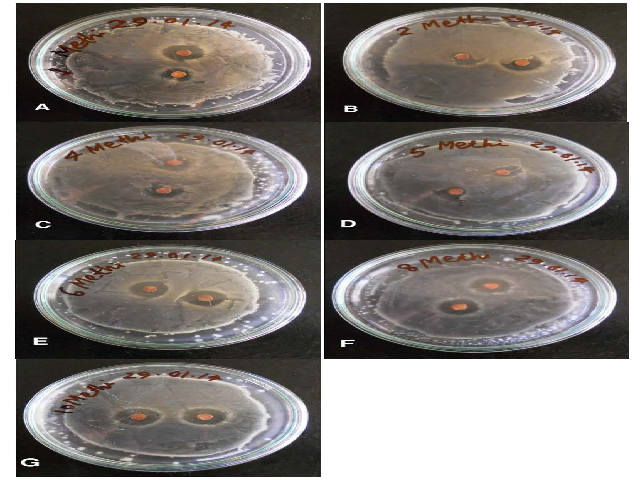GC-MS Analysis and Antibacterial Activity of Trigonella foenumgraecum against Bacterial Pathogens
DOI:
https://doi.org/10.5530/fra.2016.1.13Keywords:
T. foenum-graecum, Antibacterial activity, Disc diffusion assay, GC-MSAbstract
Objective: The purpose of this study was to investigate the chemical composition of essential oil through GC-MS and look for new antibacterial drug agents from T. foenum graecum. Methods: Bacterial strains Sarcina lutea IFO 3232, Bacillus subtilis IFO 3026, Xanthomonas campestris IAM 1671, Escherichia coli IFO 3007, Klebsiella pneumoniae ATTC 10031, Proteus vulgaris MTCC 321 and Pseudomonas denitrificans KACC 32026 were used to measure the antibacterial activity by disc diffusion assay and therefore the chemical composition of essential oil through GC-MS. Results: GC–MS analysis of the essential oil from T. foenum graecum revealed the presence of fourteen different compounds of that Decane, 5, 6-bis (2, 2 dimethylpropylidene), (E,Z)-(19.58%); Hexadecanoic acid, methyl ester (18.81%); 5, 10-Diethoxy-2, 3, 7, 8-tetrahydro-1H,6H-dipyrrolo[1, 2-a;1’, 2’-d] pyrazine (5.81%) and Octadecanoic acid, methyl ester (3.28%) were the major compounds and therefore the minor compounds were Oxiraneoctanoic acid, 3-octyl, methyl ester; Hexadecanoic acid, ethyl ester; 6-Octadecenoic acid; Cis-Calamenene; 2-Pentadecanone, 6, 10, 14-trimethyl; 1, 2, 3, 4 Tetrahydroisoquinolin- 6-ol-1-carboxylic acid and Murolan-3, 9(11)-diene-10-peroxy. The organic extracts (300 μg/disk) of T. foenum-graecum displayed antibacterial activity against Bacillus subtilis IFO 3026, Sarcina lutea IFO 3232, Xanthomonas campestris IAM 1671, Proteus vulgaris MTCC 321 and Pseudomonas denitrificans KACC 32026 with their respective zones of inhibition of 6.5 ± 0 to 8 ± 1.7 mm and the essential oil (150 μl/disk) displayed far greater potential antibacterial activity compare to those extracts against all experimental bacteria with their respective zones of inhibition of 8 ± 0 to 15 ± 0.7 mm. Conclusion: This experiment showed a great potential of antibacterial activity against gram positive and gram negative bacteria. The results of this study counsel that T. foenum-graecum might have potential use as antibacterial agents.
Downloads
Metrics





